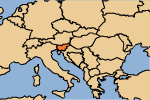url: http://edufile.info/?view=school_systems&topic=topic_general_infos&country=22&add_tag=-47
School systems Slovenia
| Kindergartens | Primary schools | Secondary schools | Higher education
Country


Slovenia (Republic of Slovenia) is a country in the Southern-Central Europe. The country covers an area of 20,273 km² and its population compromises of 2.02 million people. The official language is Slovene.
Overview

Education is compulsory from 6 to 15 years of age. There are nationwide test in the 3rd, 6th and 9th year of primary school.
Kindergartens
The attendance of kindergartens is not compulsory in Slovenia. Children from age of one to six have the opportunity to attend 19 (which accounts for 2.4% of all kindergartens) private or the remaining majority of public institutions, which are run and funded by municipalities.
The overall attendance in the academic year 2006/2007 reached 58 127 children in 793 kindergartens.
Primary schools
Primary schools are compulsory in Slovenia, established by municipalities and free of charge. They are run by the School Council (consisting of nine members: three representatives of the staff, the parents and the founder) and the appointed head teacher. Primary schooling is available to young children, adults, foreign citizens and there are also special programmes available for pupils with special needs.
The first grade is intended for children aged six in the calendar year of enrolment. Parents are by law obliged to enrol their children in the school of their choice. The compulsory length of attendance is nine years. At the end of the academic year, children receive a report with grades in individual subjects.
The academic year lasts from 1 September to 31 August of the next year. Classes of average 18.3 pupils are taught five days a week, and the minimum number of periods is 20 (first grade) to average 30 (ninth grade) depending on grade and the number of elective subjects and extra-curricular activities. (According to recent changes in legislation, the academic year is now divided into two assessment periods, but schools may keep the previous division into three assessment periods if preferred.)
The national curriculum approved by the national Expert Council for General Education determines subjects and syllabuses. Teachers choose teaching methods and textbooks autonomously. There are three cycles of education in Slovenian schools. Each one has different set of compulsory subjects and teaching methods. Grades are descriptive in the first cycle, descriptive and numerical in the second and numerical only in the third cycle. The numerical grades are 1(best) to 5 (worst). At the end of the second and third cycle, pupils take national tests, which serve only as feedback for the school, parents and pupils. These tests at the end of the second and third cycle include the mother tongue and mathematics, and at the end of the third cycle an additional, third subject, determined each year by the minister.
The extended programme offers children a choice of various extra-curricular activities (sport activities, sport competitions, school newspaper, chorus, etc.). Schools provide special lessons for very talented children, as well as those with learning difficulties.
In addition schools organise morning care and after-school care classes.
Secondary schools
There are several types of secondary schools in Slovenia: public vocational schools, secondary technical schools, vocational colleges, student residential facilities and most common gymnazija (39.3%) - grammar schools. Out of 142 secondary schools Slovenia has only 6 private ones; public schools are attended by 97.9% majority. Public schools are usually established by the state and run by the School Council consisting of nine members: three representatives of the staff, the parents and the founder. The appointed head teacher is the pedagogical leader and also a managing body himself. The students enter the schools at the age of (av.) fifteen by a unified system of application process and leave at (av.) nineteen when they complete the leaving exam: the general matura, the vocational matura or the master craftsmen examination, depending on the type of the school.
The informal learning experiences of adults without formal education are validated by The National Vocational Qualifications
The Expert Council for General Education and the Expert Council for Vocational Education determine the weekly schedule of subjects and the curriculum. In general education, compulsory subjects account for 80–90% of the curriculum (Slovene, mathematics, two foreign languages, history, geography, physical education, biology, chemistry, physics, art, psychology, sociology, philosophy and information science). In secondary technical and vocational schools, the number of compulsory subjects depends on the type of school.
Higher education
Student who pass the general matura are eligible to continue to higher education. There are four universities in Slovenia, one of which is private. There are also 23 private colleges, which offer professional studies. Higher education consists of three levels. The first level includes higher professional programmes and academic (university) programmes, the second level includes master’s programmes and the third includes doctoral programmes. The system was reformed in 2004 by the Higher Education Act, but the old system is still used in some schools.
Disabled students
Disabled students are not generally excluded; the students are placed in various types of programmes by special committees composed of experts in various fields. Placement is not based on the child’s type of disability or handicap but on his/her assessed ability for learning with regard to the programme and assistance provided within an individual programme.
All disabled children are entitled to additional help and individualised programmes.
Developments
Government has planned to create more educational institutions (universities, colleges) and to reform secondary education and is also currently trying to reduce unpopularity of scientific courses in higher education due to the lack of workforce in the field.


